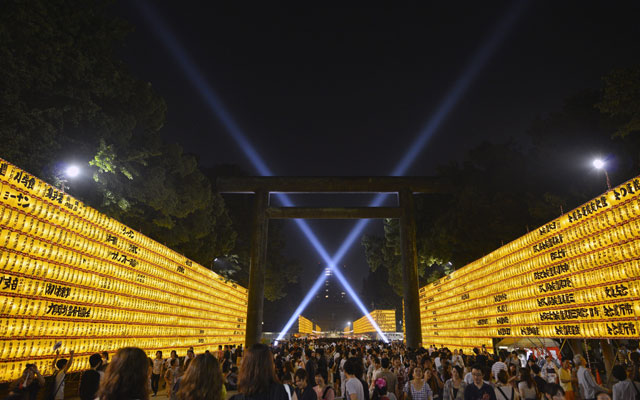Visiting Yasukuni War Memorial Stirs Controversy in Asia–Pacific
Riley Walters /

People visit the Yasukuni Shrine during the annual Mitama festival in Tokyo, Japan. (Photo: FRANCK ROBICHON/EPA/Newscom)
August 15 marks the 68th anniversary of Japan’s surrender in World War II. It is also a day when some Japanese politicians pay respect to those who have died fighting in the service of Japan and whose souls they believe are housed at Yasukuni Shrine (literally translated “Shrine of a Peaceful Nation”).
For Japan’s neighbors, Yasukuni Shrine is a controversial symbol of Japanese militarism and perceived as a lack of atonement for its wartime actions. A principle reason for this originated from the first official visit by Japan’s Prime Minister Yasuhiro Nakasone in 1985, seven years after the souls of 14 Class-A war criminals were added to the shrine.
A highly visible visit to Yasukuni by prominent Japanese figures would strain already tense relations in the Asia–Pacific. Absent a comprehensive resolution, it’s best if Japanese politicians find another way to commemorate Japan’s war dead in an official capacity, or at least in an unofficial capacity. Sources already say Prime Minister Abe is “unlikely” to visit the shrine.
Yasukuni Shrine was founded as a state shrine by Emperor Meiji in 1869. It is now a private religious Shinto corporation that commemorates almost 2.5 million Japanese soldiers.
Shinto religion observes that once a person dies, there is no connection between what that person did during his or her life and how the deceased soul should be viewed. It also implies that the souls of those departed war criminals should not be held accountable for the crimes committed during their lives. Not only are there no means of “removing” the souls from the shrine, but Yasukuni priests have also stated they have no intention of attempting to do so. As a private corporation—albeit one that may be subject to political pressure—they have the right to do as they please.
China claims that in 1985 they made an unofficial agreement with Nakasone that diplomatic ties between China and Japan would not be affected as long as the prime minister, foreign minister, and chief cabinet secretary did not visit Yasukuni Shrine. Nakasone claims that no such agreement was ever made.
Abe’s administration is already portrayed by neighboring countries as being right-wing and nationalistic, especially after a record-setting delegation of 168 Diet members, mostly from Abe’s own party, visited Yasukuni earlier this year. If this trend continues this August 15, after the recent election win by Abe’s party, it will be difficult to convince the publics of other American allies, such as South Korea, that Japan isn’t as nationalistic as they have portrayed it.
A recent poll showed 56 percent of Japanese support a visit to Yasukuni by Abe.
All nations, of course, should have the prerogative of commemorating their war dead, and the fact that politicians wishing to honor those who sacrificed their lives for their nation cannot do so without also angering their Asia–Pacific neighbors is a major problem. Nonetheless, Japanese politicians should at least have a diplomatic consciousness of what Yasukuni means to their Asian neighbors and how Japan’s pious practices are perceived.
Lastly, it should be noted that Yasukuni Shrine’s museum is unrelated to Shinto practice.
